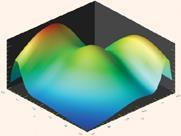A radical new approach is proposed to address the electron correlation problem.
A radical new approach offers a potential breakthrough to a fundamental problem in theoretical chemistry.
In principle, the chemical behaviour of a system can be predicted by solving its Schr?dinger equation. In practice, however, this is mathematically extremely difficult because of the need to model the complicated motion of the electrons as they try to avoid one another. This computational obstacle is known as the electron correlation problem.
Extraordinary improvements in computer hardware over the last 50 years have enabled the prediction of chemical behaviour from first principles for systems with comparatively small numbers of atoms. However, the electron correlation problem presents a formidable computational bottleneck for larger systems, and there is a pressing need for theoretical insights that will enable this to be overcome.
To address the problem, Peter Gill and colleagues from the Australian National University have proposed a radical approach that is based on a new function, the so-called Omega intracule, which provides detailed information about the relative positions and momenta of pairs of electrons within a system.

Although extremely enthusiastic about his initial results, Gill is mindful of the challenges ahead. As well as technical computational challenges, he states that ’at the fundamental level, we need a proof that this approach is mathematically sound’. He notes that the now very widely used density functional theory - for which the Nobel prize for Chemistry was awarded in 1998 - was at a similar stage of development in the 1960s.
Perhaps a more significant challenge will be winning over the minds of fellow researchers. Gill admits, ’it is always difficult to persuade the scientific community that a paradigm shift is a good thing; this is probably the most significant obstacle’.
Nevertheless, since really novel approaches to obtaining molecular energies arise only occasionally, this is a potentially very exciting development.
Philip J Earis
References
P M W Gill, D L Crittenden, D P O'Neill and N A Besley, Phys. Chem. Chem. Phys., 2006, (DOI:10.1039/<MAN>b511472a</MAN>)






No comments yet